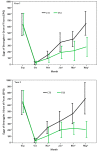Control of Strongyles in First-Season Grazing Ewe Lambs by Integrating Deworming and Thrice-Weekly Administration of Parasiticidal Fungal Spores
- PMID: 34684288
- PMCID: PMC8538233
- DOI: 10.3390/pathogens10101338
Control of Strongyles in First-Season Grazing Ewe Lambs by Integrating Deworming and Thrice-Weekly Administration of Parasiticidal Fungal Spores
Abstract
Parasiticidal fungi have been used in several in vivo experiments in livestock farms worldwide, constituting an effective tool for the biocontrol of gastrointestinal parasites in grazing animals. In the first year of study, two groups of eight first-season pasturing ewe lambs infected by strongyles were dewormed with albendazole, and then, the test group received an oral dose of 106 chlamydospores of Mucor circinelloides and 106 Duddingtonia flagrans individually and thrice a week from mid-September to May (FS1), while the control group remained without fungi (CT1). In the second year, two new groups of first-season grazing ewe lambs were treated with ivermectin and subjected to the same experimental design (FS2 and CT2, respectively). The anthelmintic efficacy was 96.6% (CT1), 95.6% (FS1), 96.1% (CT2), and 95.1% (FS2). The counts of strongyle egg output increased in the control groups (CT1 and CT2) throughout the study and reached numbers higher than 600 eggs per gram of feces (EPG), while in FS1 and FS2, they were <250 EPG. The values of red blood cell parameters registered for CT1 and CT2 were lower than those of the reference standards, while a significant increment was recorded in FS1 and FS2, and values within the physiological range were attained. It is concluded that integrating efficient anthelminthic deworming with rotational pasturing and the regular intake of chlamydospores of M. circinelloides and D. flagrans provides a helpful strategy for maintaining low levels of strongyle egg output in first-season grazing ewe lambs and improves their health status.
Keywords: Duddingtonia flagrans; EPG counts; Mucor circinelloides; biological control; hematic parameters; ovine; soil-transmitted helminths.
Conflict of interest statement
The authors declare no conflict of interest. The funders had no role in the design of the study; in the collection, analyses, or interpretation of data; in the writing of the manuscript; or in the decision to publish the results.
Figures


References
-
- Charlier J., Morgan E., Rinaldi L., van Dijk J., Demeler J., Höglund J., Hertzberg H., Van Ranst B., Hendrickx G., Vercruysse J., et al. Practices to optimise gastrointestinal nematode control on sheep, goat and cattle farms in Europe using targeted (selective) treatments. Vet. Rec. 2014;175:250–255. doi: 10.1136/vr.102512. - DOI - PubMed
-
- Furgasa W., Abunna F., Yimer L., Haile G. Review on anthelmintic resistance against gastrointestinal nematodes of small ruminants: Its status and future perspective in Ethiopia. J. Vet. Sci. Ani Husb. 2018;6:407.
-
- van den Pol-van Dasselaar A., Hennessy D., Isselstein J. Grazing of Dairy Cows in Europe—An in-depth analysis based on the perception of grassland experts. Sustainability. 2020;12:1098. doi: 10.3390/su12031098. - DOI
LinkOut - more resources
Full Text Sources

